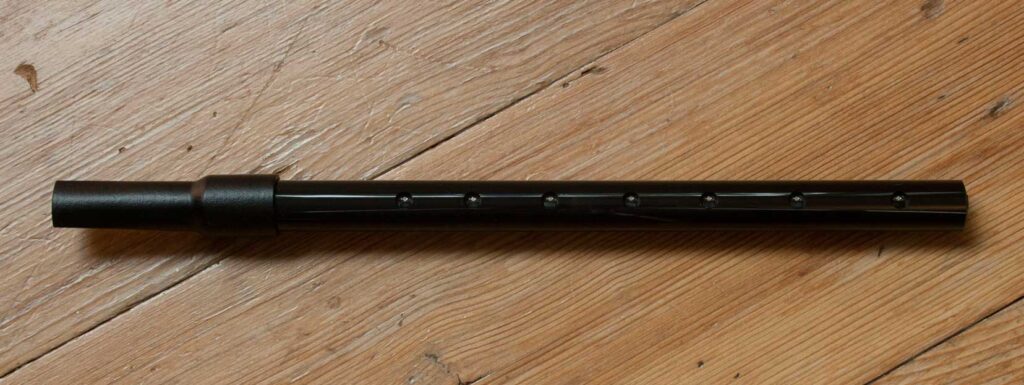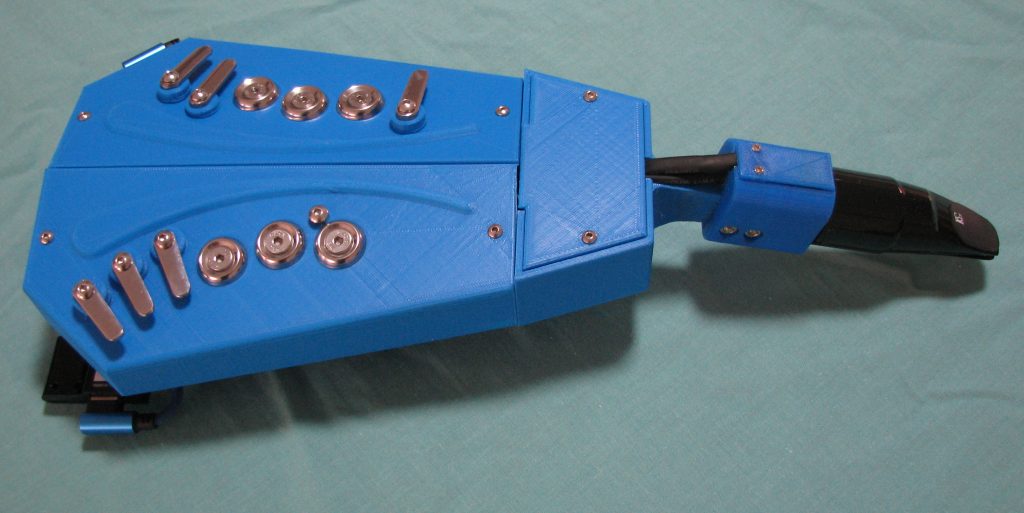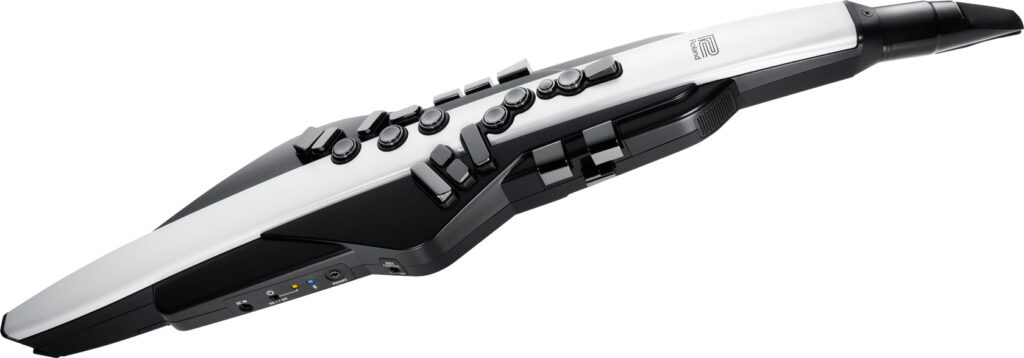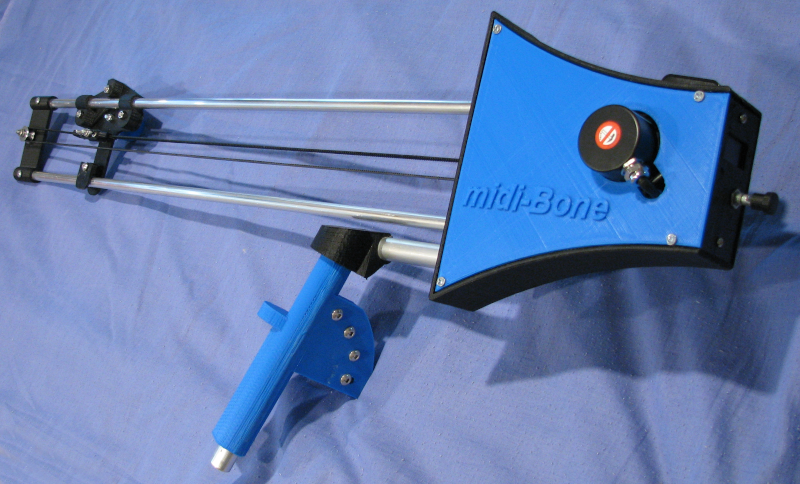Updated 10 June 2024
Here are some comments about my MIDI wind instruments.
EWI-USB

I’ve had the Akai-Pro EWI-USB for a number of years now. It’s still a current model, and there’s a good reason for that – it’s a great instrument!
It is “only” a wind controller – It needs an external synth to make sounds, and those sounds are only as good as the external synth is. It is powered from the synth via the USB cable.
Pros:
- It’s light
- It’s robust
- The keys are touch sensitive, enabling really fast keying
- It has a number of fingering options
- It has enough keys to make alternative fingering easy
Cons:
- It has no built-in synth (this may be a +ve)
- To adjust the configuration you need to use a computer
- The configuration settings are limited (eg breath)
- I’m not particularly fond of the bite action – you can’t play it like a sax mouthpiece
- It doesn’t have “extra” buttons for sending commands to the synth
- It has no wireless MIDI function
EWI-Plus
I built the EWI-Plus to overcome the Cons of the EWI-USB. It replaces all the internal components of the ERI-USB.

See my project page EWI-Plus
This is now my preferred instrument.
Warbl

The Warbl is a really well thought-out instrument. It is primarily intended for tin-whistle and bagpipe players who want to play electronically. It is fun to play, and for me the note “slide” action is one of its outstanding features. It is not an all-purpose instrument because it doesn’t have enough finger keys to be able to play in, say, a concert band – it’s too hard to play in keys with lots of sharps and flats. However, that’s not what it is for. I use mine in a baroque recorder group, and it does just fine.
Update: I’ve just bought the Warbl 2. It works just like the first Warbl, but it has battery power, BLE MIDI and a gyroscope/accelerometer
As with the EWI-USB, you need an external synth, and the instrument is powered either from the synth (Warbl 1 and 2), or via re-chargeable battery (Warbl2)
The inventor, Andrew, is doing on-going development, and is easily approachable.
Pros:
- It’s really light and small (same size as a tin-whistle)
- It works well as a tin-whistle/bagpipe
- It’s robust
- It has many fingering options
- The keys have the ability to “slide” onto notes
- The configuration settings are really comprehensive
- It has a configuration app
- It has BLE MIDI (Warbl 2)
- It has extra buttons for either configuring the instrument on-the-fly, or for sending commands to the synth
- The Warbl 2 has a gyroscope/accelerometer which you can program to to all sorts of things. I use it for vibrato and for increasing the number of octaves (by changing the angle of the instrument)
Cons:
- I has no built-in synth
- to adjust the configuration you need to use a computer or tablet
- It has a limited number of keys, making alternate keying difficult, and limiting the number of octaves
- There is no bite action
- It has no wireless MIDI function (Warbl 1)
Midi-Sax

This is an instrument I built myself. I built it because a) it was in the middle of COVID, and I had nothing to do, and b) I wanted to try and improve on the EWI-USB. You can read about its development here. The result is an instrument that I use most of the time. It performs essentially the same functions as the EWI-USB, PLUS the following:
- It has built-in wireless MIDI
- it has built-in configuration (no need for a computer)
- it has better breath configuration options
- It has extra buttons for sending commands to an external synth
- It has faster breath response
- It now has bite pitchbend as I found a neat way of implementing it
It’s only drawback is that, because it’s a prototype, it is not really robust – it can be damaged with rough handling.
e-WB

This instrument is essentially the same as the midi-Sax above – I transplanted the insides from the midi-Sax. I tried replacing the processor with a RPi Pico controller, but it wasn’t fast enough. I decided to use side-by-side hand position to make it more compact. It’s a lot more robust than the midi-sax.
Aerophone AE-20

I’ve sold this instrument (May 2023), but I thought I’d leave the comments here…
This instrument is a result of a few years of development by Roland. I had the previous incarnation of it (AE-10), and this is a significant improvement. Read my review here. Roland is openly targeting sax players and the instrument has many features that sax players will find comfortable. It has a built-in synth, so the only other equipment you need to make music is an amplified speaker. The internal synth is very powerful and configurable – I have only scratched the surface of its abilities. That said, the instrument can also function well driving an external synth (in the same way the EWI does).
The reason I like this instrument so much is that its mouthpiece has a bite sensor that is like a sax reed. As far as I know Roland are the only ones to make the bite sensor like this, and it works really well (for me).
Pros:
- It’s robust
- It has a powerful built-in synth
- It is self-powered (6x AA rechargeable batteries)
- The keys are in saxophone configuration ( a +ve if you like that sort of thing)
- It has a number of fingering options, including various custom fingering features
- It has enough keys to make alternative fingering easy
- It has a great bite sensor mechanism
- It has built-in Bluetooth
- It has built-in configuration (no need for a computer)
- It has an app for intricate configuration
Cons:
- It’s weighty (more than any of the instruments above, but less than an acoustic sax)
- I’m not a fan of the flute preset (which, unfortunately, is the sound I use most)
Midi-Bone
This is one from left field. I built it, it works, but I can’t get my head around using the slide…

Read all about it here. I needs an external synth for sound and power, and has it’s own built-in config. Not sure what to do with it…